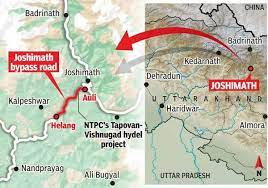Geography
Study on Joshimath Sinking
- 27 Sep 2023
- 7 min read
For Prelims: Himalayas, Earthquakes, Landslides, Joshimath, Land Subsidence, ISRO
For Mains: Impact of Natural and Anthropogenic Factors on Joshimath Sinking
Why in News?
Recently, separate studies were conducted by eight premier institutions of India including the Indian Space Research Organisation (ISRO) to know the cause of land subsidence in Joshimath town of Uttarakhand and provided independent reasons for the sinking of the Himalayan town.
What are the Reports by Institutions about Joshimath Sinking?
- Central Building Research Institute (CBRI):
- In its report, the CBRI stated that Joshimath town has 44%, 42%, 14% of masonry, RCC and other (traditional, hybrid) construction typologies, respectively, among which 99% are non-engineered.
- These structures are not in compliance with the National Building Code of India, 2016.
- Other Findings:
- Joshimath town is situated on Vaikrita groups of rocks (made up of coarse mica-garnet-kyanite and sillimanite-bearing psammitic metamorphics) overlain by morainic deposits which are composed of irregular boulders and clay of varying thicknesses.
- Such deposits are less cohesive and susceptible to slow subsidence and landslide subsidence.
- In its report, the CBRI stated that Joshimath town has 44%, 42%, 14% of masonry, RCC and other (traditional, hybrid) construction typologies, respectively, among which 99% are non-engineered.
- National Institute of Hydrology (NIH) Report:
- It mapped various springs, drainage networks and areas of subsidence inferring that land subsidence and subsurface water in Joshimath might have some connections.
- The institution recommended the safe disposal of the water coming from the upper reaches and waste disposal as the top priority.
- Wadia Institute of Himalayan Geology (WIHG) Report:
- Institution mentioned earthquakes as a reason for slow and gradual land subsidence.
- The main reason for the subsidence appears to be internal erosion caused by the subsurface drainage, which may be due to infiltration of rainwater/melting of ice/wastewater discharge from households and hotels.
- ISRO’s stand:
- The subsidence in the Joshimath region may be due to the toe-cutting phenomenon.
- Also due to slope instability as a result of seepage of local drainage water in the soil.
- Terrain and edaphic characteristics are also responsible for subsidence.
- Loose and unconsolidated moraine materials of the slope (due to old landslides) and flash flood events in and around the area in the recent past, also contributed to land sinking.
Where is Joshimath Located?
- Joshimath is a hilly town located on the Rishikesh-Badrinath National Highway (NH-7) in Chamoli district of Uttarakhand.
- The city serves as a tourist town as it acts as an overnight rest stop for people visiting Badrinath, Auli, Valley of Flowers, and Hemkund Sahib, among other important religious and tourist locations in the state.
- Joshimath is also of great strategic importance to the Indian armed forces and is home to one of the Army's most important cantonments.
- The town (falls in high-risk seismic Zone-V) is traversed by running streams with a high gradient from Vishnuprayag, a confluence of the Dhauliganga and the Alaknanda rivers.
- It is home to one of the four cardinal Maths or monasteries established by Adi Shankara - Sringeri in Karnataka, Dwarka in Gujarat, Puri in Odisha and Joshimath near Badrinath in Uttarakhand.
What can be done to save Joshimath?
- Experts recommend a complete shutdown of development and hydroelectric projects in the region. But the urgent need is to relocate the residents to a safer place and then reimagine the town's planning to accommodate the new variables and the changing geographical factors.
- Drainage planning is one of the biggest factors that needs to be studied and redeveloped. The city is suffering from poor drainage and sewer management as more and more waste is seeping into the soil, loosening it from within. The irrigation department has been asked by the state government to look into the issue and create a new plan for the drainage system.
- Experts have also suggested replantation in the region, especially at the vulnerable sites to retain soil capacity. There is a need for a coordinated effort between the government and civil bodies with the aid of military organizations like the Border Roads Organisation (BRO) to save Joshimath.
- While the state already has weather forecasting technology that can warn people of local events, its coverage needs to be improved.
- The state government also needs to take scientific studies more seriously, which clearly spells out the reasons for the current crisis.
What is Landslide?
- A landslide is defined as the movement of a mass of rock, debris, or earth down a slope.
- They are a type of mass wasting, which denotes any downward movement of soil and rock under the direct influence of gravity.
- The term landslide encompasses five modes of slope movement: falls, topples, slides, spreads, and flows.
UPSC Civil Services Examination Previous Year Questions (PYQs)
Mains
Q. Bring out the causes for more frequent landslides in the Himalayas than in Western Ghats. (2013)
Q. Describe the various causes and the effects of landslides. Mention the important components of the National Landslide Risk Management Strategy. (2021)







